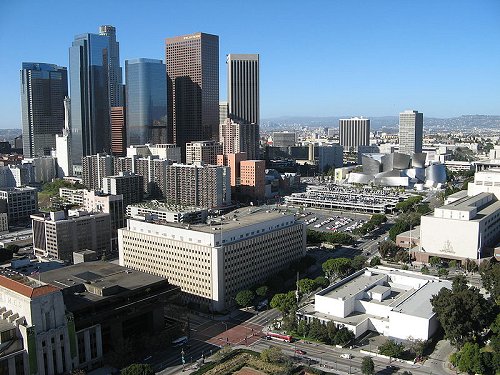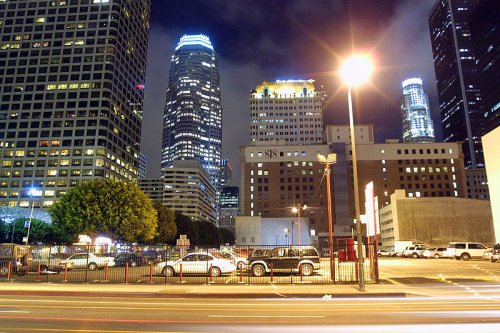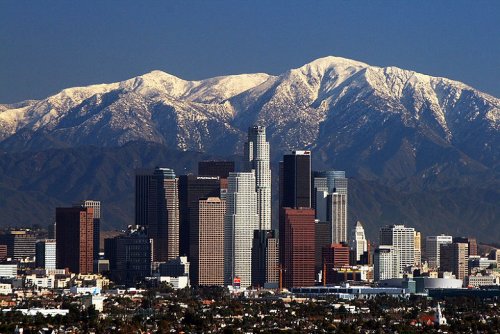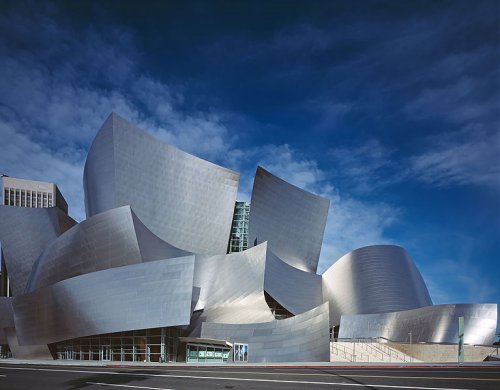 Downtown Los Angeles at sunset
Downtown Los Angeles at sunsetSource: https://commons.wikimedia.org/wiki/File:Los_Angeles_downtown_sunset_cityscape.jpg
Author: Matthew Field

Los Angeles is the largest city in the state of California and the second-largest city in the United States of America. Often called L.A., Los Angeles is a world-renowned global city with an estimated 2006 population of 3.8 million.
Los Angeles covers an area of 469.1 square miles (1,214.9 square kilometers) in Southern California, making it the 14th largest city in land area in the United States. The city extends 44 miles longitudinally and 29 miles latitudinally. The metropolitan area of Los Angeles-Long Beach-Santa Ana metropolitan area is home to nearly 13 million people. Los Angeles is the seat of Los Angeles County, the most populous county in the United States. The people of Los Angeles are called "Angelenos." The city's most popular nickname is the "City of Angels". Despite popular misconception, Los Angeles is not the state capital of California.
 Bunker Hill in downtown Los Angeles
Bunker Hill in downtown Los AngelesSource: https://commons.wikimedia.org/wiki/File:Bunker_Hill_Downtown_Los_Angeles.jpg
Author: Geographer

Getting into Los Angeles
The main airport serving Los Angeles is the Los Angeles International Airport (LAX). This giant airport has nine terminals. A free shuttle bus takes passengers from terminal to terminal. You can also walk from one terminal to another in about 10 minutes - in fact, it will be quicker to walk if you are transfering to an adjacent terminal.To get out of the airport, you can take the LAX FlyAway shuttle bus to Union Station for $6.00 one way. Taxis to downtown Los Angeles costs $45 and takes 30 minutes if the traffic is smooth. Many people rent a car - there are ten different car rental companies at your disposal. The most convenient and practical way to move about in Los Angeles - unfortunately - is to drive.
 Downtown Los Angeles at night
Downtown Los Angeles at nightSource: https://commons.wikimedia.org/wiki/File:LosAngeles02.jpg
Author: Thomas Pintaric

Travel within in Los Angeles
I wish I can recommend public transport but for the case of Los Angeles, you are better off driving. The public transportation here is poor and erratic. Unless you have unlimited amount of time, it is not the mode of transportation that I could recommend. Having said that, there is a number of places you can go using the Metro Rail. Although not as extensive as New York City's subway, better that than trying to get familiar with the roads.Los Angele's Metro Rail is a light rail system that serves Los Angeles County. You can use it to visit many of the sightseeing places in the city. A single-trip fare is $1.25. You can buy the ticket from the vending machines. If you intend to use it extensively, get the pass for unlimited rides. The day pass costs $5.00 and is good till 3:00 am of the following morning. The weekly pass costs $17.00 and would be good enough for most visitors. There is also a monthly pass for $62.00. You can buy the day passes from the vending machines while the weekly and monthly passes are available from the Metro Customer Centres.
 Los Angeles, California
Los Angeles, CaliforniaSource: https://commons.wikimedia.org/wiki/File:LA_Skyline_Mountains2.jpg
Author: Nserrano

Los Angeles History
Los Angeles was founded in 1781 by Spanish governor Felipe de Neve as El Pueblo de Nuestra Señora la Reina de los Ángeles de Porciúncula, which translates as "The Village of Our Lady, the Queen of the Angels of Porciúncula". It became a part of Mexico in 1821 following its independence from Spain. In 1848 at the end of the Mexican-American War, Los Angeles and California were integrated as part of the United States. It was incorporated as a municipality on April 4, 1850, five months before California achieved statehood. Los Angeles is prominent on the world stage as a center for culture, technology, and international trade. It is also a leading center for the entertainment industry, including motion picture, television, and recorded music, a sector that propers Los Angeles' international fame and global status.Los Angeles Geography
The highest point in Los Angeles is Mount Lukens, also called Sister Elsie Peak (5,080ft, 1,548m), at the far reaches of the northeastern San Fernando Valley. The Los Angeles River is a major river in Los Angeles, although it is lined in concrete for almost its entire length as it flows through the city to the Pacific Ocean.Los Angeles is notorious for being prone to earthquakes, due to its location in the Pacific Ring of Fire. The geologic instability produces approximately 10,000 earthquakes every year, although the majority are too small to be felt. The San Andreas Fault is one of the major fault lines in Los Angeles. Among the big earthquakes to have hit the Los Angeles area include the 1994 Northridge earthquake, the 1987 Whittier Narrows earthquake, the 1971 San Fernando earthquake near Sylmar, and the 1933 Long Beach earthquake.
 Walt Disney Concert Hall, Los Angeles
Walt Disney Concert Hall, Los AngelesSource: https://commons.wikimedia.org/wiki/File:Disney_Concert_Hall_by_Carol_Highsmith_edit2.jpg
Author: Carol M. Highsmith

Los Angeles Climate
Los Angeles enjoys a Mediterranean climate. It experiences mild, somewhat wet winters and warm to hot summers. Breezes from the Pacific Ocean tend to keep the beach communities of the Los Angeles area cooler in summer and warmer in winter than those further inland; summer temperatures can sometimes be as much as 18°F (10°C) warmer in the inland communities compared to that of the coastal communities. A few coastal areas have never recorded a temperature below freezing.Temperatures in the summer can get well over 90°F (32°C), but average summer daytime highs in downtown are 82°F (27°C), with overnight lows of 63°F (17°C). Winter daytime high temperatures will get up to around 65°F (18°C), on average, with overnight lows of 48°F (10°C) and during this season rain is common. The warmest month is August, followed by July and then September.
The rain in Los Angeles occurs mainly in the winter and spring months. February is the wettest month. Los Angeles averages 15 inches (38 cm) of precipitation per year. Snow is rare within the city, but the mountainous slopes within city limits typically receive snow every year. The greatest snowfall recorded in downtown Los Angeles was 2.0 inches (5 cm) on January 15, 1932.
Los Angeles Neighborhoods
Los Angeles is divided into many neighborhoods, many of which were towns that were annexed by the growing metropolis. There are also several independent cities in and around Los Angeles, but they are popularly grouped with the city of Los Angeles, either due to being completely engulfed as enclaves by Los Angeles, or lying within its immediate vicinity. Generally, the city is divided into the following areas: Downtown Los Angeles, the Eastside, South Los Angeles, the Harbor Area, Hollywood, Wilshire, the Westside, and the San Fernando and Crescenta Valleys. Well-known communities include Watts, Venice Beach, the Downtown Financial District, Los Feliz, Silver Lake, Hollywood, Hancock Park, Koreatown, Westwood and the more affluent areas of Bel-Air, Benedict Canyon, Hollywood Hills, Pacific Palisades, and Brentwood.Places of Interest in Los Angeles
- Angels Flight
- Bradbury Building
- El Pueblo
- Farmers Market
- First Interstate World Center
- Grand Central Market
- Hollywood Sign
- Los Angeles Central Library
- Los Angeles Children's Museum
- Los Angeles City Hall
- Lummis House
- Mulholland Drive
- Museum of Tolerance
- Music Center
- Southwest Museum of the American Indian
- The Getty
- Union Station
- Universal Studios
- US Bank Tower
- California Afro-American Museum
- California Museum of Science and History
- Los Angeles Memorial Coliseum
- Natural History Museum of Los Angeles County
- University of Southern California
- Autry National Center
- Greek Theater
- Griffith Observatory
- Los Angeles Zoo
- Travel Town
- Geffen Contemporary at MOCA
- Japanese American National Museum
- Museum of Contemporary Art
- Craft and Folk Art Museum
- Los Angeles County Museum of Art
- Page Museum at the La Brea Tar Pits
- Peterson Automative Museum
- Beverly Hills Civic Center
- Museum of Television and Radio
- Rodeo Drive
- 2 Rodeo
- Armand Hammer Museum of Art and Culture
- Fowler Museum of Cultural History
- Mildred E. Mathias Botanical Garden
- UCLA
- Westwood Memorial Park
- Disneyland
- Knott's Berry Farm
- Mission San Juan Capistrano
- Newport Beach
- Watts Towers
Places in the vicinity of Los Angeles
- Beverly Hills
City to the west of downtown Los Angeles. - Hollywood
District in Los Angeles famous for its entertainment and motion picture industry. - Long Beach
City on the Pacific coast of Los Angeles County. - Malibu
Affluent coastal neighborhood favored by celebrities as their seaside residence. - Pasadena
City in Los Angeles County. - Santa Monica
City on Santa Monica Bay to the west of downtown Los Angeles - Venice
Beachfront district of Los Angeles, today a popular tourist destination. - Westwood
Neighbourhood on the Los Angeles Westside region, in western Los Angeles County.
 Latest updates on Penang Travel Tips
Latest updates on Penang Travel Tips

Copyright © 2003-2025 Timothy Tye. All Rights Reserved.

 Go Back
Go Back